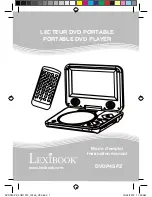
581 Disc Player
6
7
Optimizing the Output Level
Best performance is obtained when operating the Wadia Volume Control near the top of its range. If needed,
the maximum output level of your Wadia 581 Disc Player can be adjusted to match the overall sensitivity of your
system so that the critical listening will take place with the volume control operating near the top of its range.
The maximum output level of the Wadia 581 Disc Player is adjustable by means of a set of internal switches.
The Wadia 581 Disc Player is factory set to accommodate the most common range of system sensitivity. If
you find that your typical volume level during critical listening is below 65 on the volume display, it will be
advantageous to use a different setting. To change the output level, consult your dealer.
.
Connecting to Other Digital Sources
The Wadia 581
i
Disc Player is equipped with digital inputs which can accept digital signals from any of the
established digital formats. Input 1: Glass-fiber optical Input 2: Coaxial with BNC connector Input 3: Plastic-optical
TOSLINK Input 4: AES/EBU with XLR connector
The Wadia 581
i
Disc Player digital inputs will decode any word length up to 24-bit, and any of the standard
digital audio sampling frequencies up to 96kHz.
Choosing a Digital Cable
(Wadia 581i only)
While the Wadia 581
i
Disc Player supports all currently accepted transmission formats for digital audio, we
recommend using a high quality glass-fiber cable such as the one available from Wadia. Wadia Digital was the
first company to use glass fiber-optic data transmission in digital audio. We have continually improved this
format and believe that it offers the best, most consistent performance of all the available options.
Based on our experience, here is a list of digital interface methods in descending order of performance:
1 Glass optical (as implemented by Wadia)
2 AES/EBU using XLR connector
3 Coaxial cable using BNC connector
4 Coaxial cable using RCA connector
5 TOSLINK plastic-optical cable
The quality of any of these transmission methods depends on the quality of the cable and the sophistication of
the transmitter and receiver. For example, a high quality coaxial cable can outperform a low quality AES/EBU
cable. A high quality AES/EBU cable will outperform a poorly implemented glass optical system.
If you are using a coaxial cable we recommend that you have the cable terminated with a BNC connector. This
will provide higher performance than an RCA connector. Your Wadia 581 comes with an RCA/BNC adapter that
can be used for experimentation between different types of coaxial cable.
Again, we highly recommend that you take advantage of your dealer’s experience and, most importantly,
trust your ears.
All XLR-type inputs and outputs on the Wadia 581
i
Disc Player, both digital and analog, use the standard audio
pin configuration:
Pin 1 - Ground
Pin 2 - Positive signal
Pin 3 - Negative signal
Frequently Asked Questions
Should I use a Balanced or Unbalanced connection?
If your amplifier has a true balanced input, we recommend you use the balanced analog output from your
Wadia 581 Disc Player. All things being equal, properly implemented balanced (also called differential) circuitry
sounds better than unbalanced circuitry. The Wadia 581 Disc Player is a true balanced design. It generates the
inverted signal in the digital domain and all subsequent processing is done in balanced mode. Your Wadia 581
Disc Player is designed to maintain many of the advantages of true balanced design when using the unbalanced
outputs. In addition, the Wadia 581 output stage is capable of driving both types of outputs simultaneously.
Why should I bypass the Preamplifier?
A preamplifier is unnecessary when using your Wadia 581 Disc Player. The Wadia 581 Disc Player provides all
the necessary control functions of a preamp while the signal is still in the digital domain. This avoids the sonic
degradation caused by analog circuitry, switches, and wire. The Wadia 581 Disc Player output stage can drive
any power amplifier and any interconnects, even at very long lengths.
Does the Wadia Volume Control compromise resolution?
The Wadia 581 Disc Player uses the latest generation of Wadia’s proprietary digital volume control. The volume
level can be varied in the digital domain by means of mathematical manipulation of the signal, eliminating the
distortion and noise that are inevitable with even the best analog volume controls. While conventional thinking
indicates that reducing the volume digitally can sacrifice low level resolution, Wadia has created an innovative
solution. Wadia’s patented digital filtering algorithm produces a 24 bit output rather than the 16 bits stored on
the CD. This high-resolution signal is then used in the computations which in turn reduce the volume level. This
new signal is fed directly to the DAC chips. Through this innovative method, the Wadia 581 Disc Player main-
tains high resolution even at the lowest volume control settings.
Can I bypass the Wadia Volume Control?
Because the Digital Volume control does not include any analog circuitry, there is none to be bypassed. Even
the mathematical program step that performs the Digital Volume Control calculation is an integral part of the
Wadia DigiMaster filter algorithm and therefore cannot be bypassed. If you do not need the Wadia Volume
Control, set it to its maximum level of 100 on the display.
What about Analog Sources?
In order to fully realize the potential of this type of system, Wadia has a range of Analog-to-Digital converters.
Now it is possible to use analog sources, such as a tuner, tape deck, or even a turntable (in conjunction with a
suitable phono stage) in your system without using a conventional analog preamplifier. Consult your dealer for
more information on the Wadia Analog-to-Digital products.
Should I leave the Wadia 581
Disc Player
with the power on?
The Wadia 581 Disc Player is designed to be left with the power on with no harm or wear to the unit. All
motors and laser circuitry turn off when the unit stops playing. If desired, the front display can be turned off
(see
Turning off the Display
under
Remote Operation
). Leaving the power on allows the circuitry to remain
in thermally stable, which provides better performance and longer life. Careful listeners will notice that the
sound of the Wadia 581 Disc Player will improve steadily after the unit is poweredup. A new unit will undergo
more dramatic changes when power is applied for the first time. If you turn off your Wadia 581 for more than an
hour, you will find that the unit will undergo similar, but less dramatic improvement once power is reapplied.




























